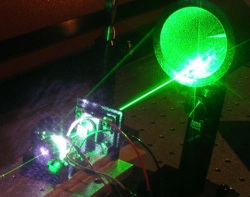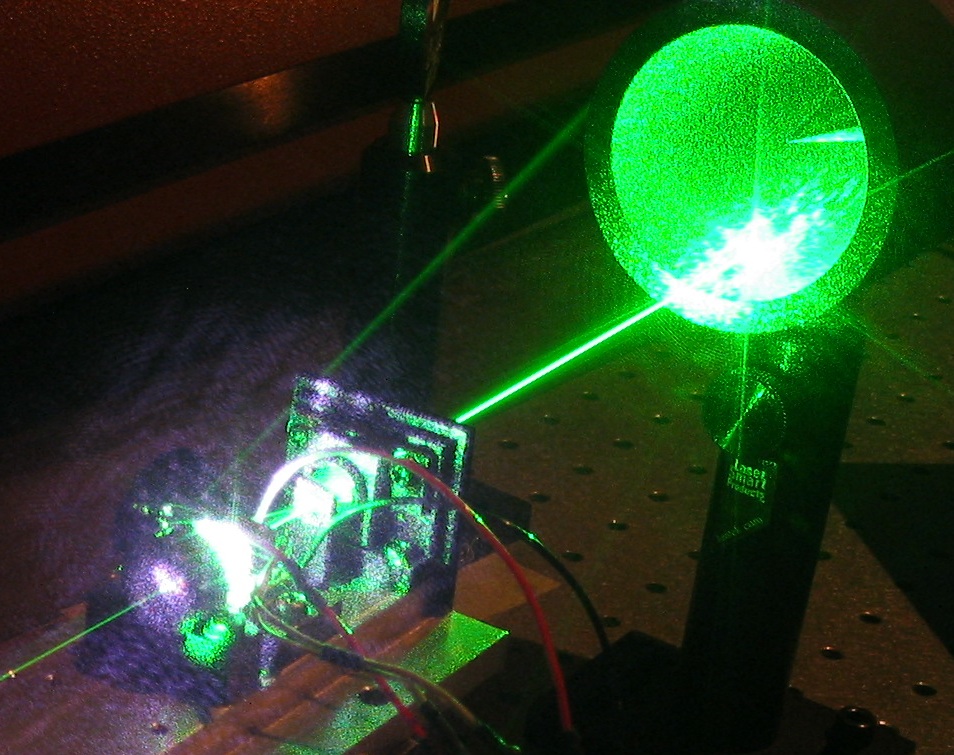The Overlap of Two Photons
Physicists routinely use a movable mirror to measure the timing of laser pulses that are only femtoseconds seconds) long, and now they have extended the technique to pairs of photons. A team reporting in the 18 September Physical Review Letters studied “entangled” photons, which are created in pairs and maintain a quantum connection with their mates. Such photon pairs may be useful for quantum computers and cryptography, and this new technique could complement others aimed at revealing their properties.
To measure ultrafast phenomena, researchers often use repetitive trains of very short laser pulses. For example, they can create two pulse trains from the same source and send them along different paths. To measure the length of the pulses within the trains, they shine both at a “nonlinear” crystal. The crystal produces extra light with double the original frequency when two pulses are present simultaneously. By changing the path followed by one train, perhaps making it a micron or so longer, researchers create a delay of a few femtoseconds. As they increase the extra path length, pulses from the two trains become out of sync, which reduces the crystal’s output and indicates the length of the pulses.
Doubling requires intense light, so researchers didn’t think this method would work for something as dim as two photons. But “modern crystals are quite strong in their nonlinearities,” so they have high sensitivity, says Kevin O’Donnell, of the Center for Scientific Research and Higher Education of Ensenada (CICESE) in Mexico. And the well-developed technology for generating entangled pairs of photons has several technical benefits. Making such pairs also involves a nonlinear crystal: Shining a steady pump laser on the crystal under the right conditions occasionally produces the photon pairs, each with about half the energy of those in the pump beam.
Quantum mechanics prohibits measurement of the length of a single entangled photon, but we are allowed to measure properties of the pair. In a previous experiment looking at the duration of overlap of photon pairs, published in 2005, a team from the Weizmann Institute of Science in Rehovot, Israel, relied on the fact that the two photons usually have slightly different frequencies [1]. The team sent the pair through a filter that shifts the phase of light differently at different frequencies and then sent them into a second nonlinear crystal. Measuring the crystal output for various filters–mathematically equivalent to sending the higher- and lower-frequency photons on different-length paths–allowed the Weizmann team to measure the overlap time of the pairs. Now O’Donnell and Alfred U’Ren of the National Autonomous University in Mexico City have used a simpler method, sending the two photons on spatially separated paths, analogous to the standard experiment with pulse trains.
O’Donnell and U’Ren used two mirrors to direct the pairs onto the nonlinear crystal, one for each of the photons. By moving one mirror back and forth, they could shift the arrival time of one photon without the complex reshaping introduced by the filter in the Weizmann experiment. O’Donnell says that only one pair out of about ten million is doubled, and it took “several months of working in the dark” to get the apparatus adjusted correctly. He and U’Ren found that a delay or advance of one of the pair by about 14 femtoseconds reduced the crystal’s doubled output by half. This time corresponds to a full correlation (overlap) length of 8 microns. O’Donnell cautions that, despite the similarity to the traditional technique, this length is a property of the entangled pairs, not a measure of the duration of individual photons.
Weizmann researcher Barak Dayan thinks the new results are mostly similar to the earlier work, in which he participated. But he says the new technique may have an advantage when one wants the two photons to be identical, rather than having distinct frequencies.
–Don Monroe
Don Monroe is a freelance science writer in Murray Hill, New Jersey.
References
- A. Pe’er, B. Dayan, A. A. Friesem, and Y. Silberberg, “Temporal Shaping of Entangled Photons,” Phys. Rev. Lett. 94, 073601 (2005)





